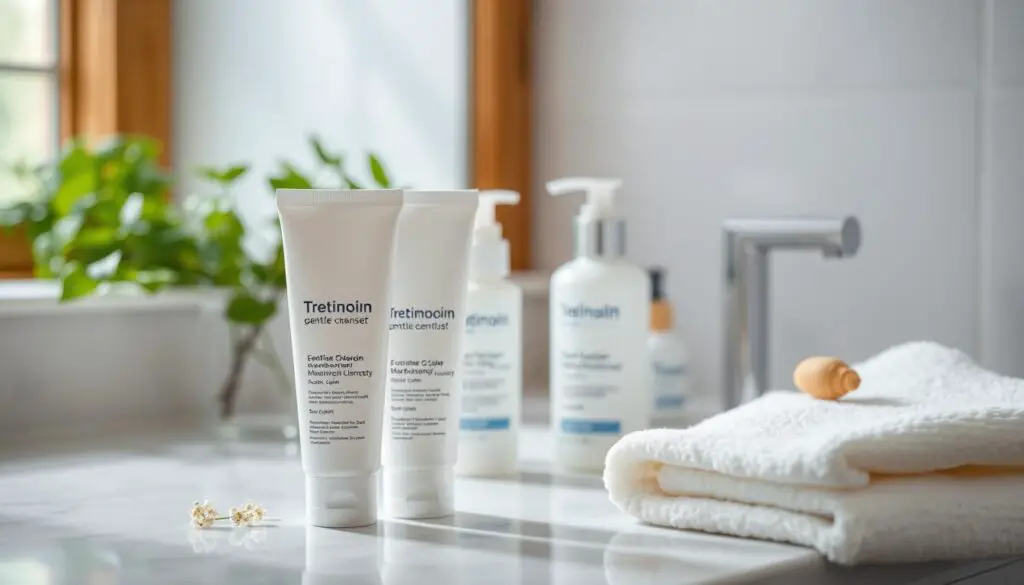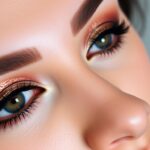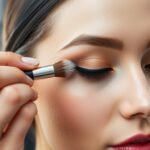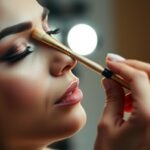Are you tired of fighting stubborn skin issues without seeing results? What if a powerful solution could change your skin’s look and tackle many problems at once?
Tretinoin might be the answer you’ve been looking for in your tretinoin skincare regimen. This strong vitamin A derivative has changed skincare by targeting acne, sun damage, and aging signs with great accuracy.
Creating a good skincare routine with tretinoin needs patience and planning. Your skin needs a gentle start with this strong treatment to avoid irritation and get the best results. Knowing how to use tretinoin right can turn frustrated skin into a radiant glow.
The secret to success is slow and careful steps and choosing the right products. Your tretinoin skincare plan should match your skin type, focusing on keeping it hydrated, protected, and consistently treated. With expert advice, you can unlock the amazing benefits of this skincare solution.
Table of Contents
Understanding Tretinoin and Its Benefits
Skincare lovers are looking for powerful ingredients that change their skin. Tretinoin is a standout for tackling many skin problems with proven results.
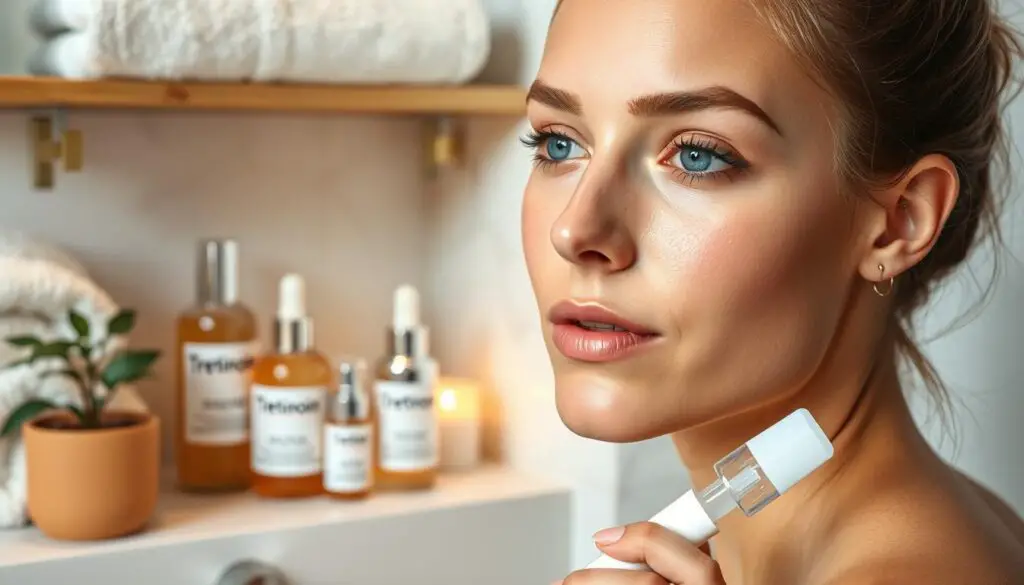
What is Tretinoin?
Tretinoin is a strong retinoid made from vitamin A. It’s known for making skin healthier by speeding up cell turnover and boosting collagen. Dermatologists often suggest tretinoin for its wide range of benefits.
How Does Tretinoin Work?
Tretinoin works in a unique way. It affects skin cells to:
- Boost skin cell regeneration
- Unclog pores
- Stimulate collagen production
- Normalize skin cell function
Common Skin Issues Treated with Tretinoin
Knowing how to use tretinoin can help with many skin problems. Here’s a list of issues it can fix:
| Skin Condition | Tretinoin’s Impact |
|---|---|
| Acne | Reduces inflammation, prevents breakouts |
| Fine Lines | Stimulates collagen, reduces appearance |
| Uneven Skin Tone | Promotes even pigmentation |
| Sun Damage | Repairs and reverses environmental damage |
*”Tretinoin is not just a treatment, it’s a skincare transformation.”*
Users often see big changes in 8-12 weeks of regular use. Keep in mind, results can differ. Always talk to a dermatologist for advice tailored to you.
Preparing for Your Tretinoin Journey
Starting a tretinoin skincare journey needs careful planning. Before using this powerful treatment, you must take important steps. These steps ensure safe and effective use.
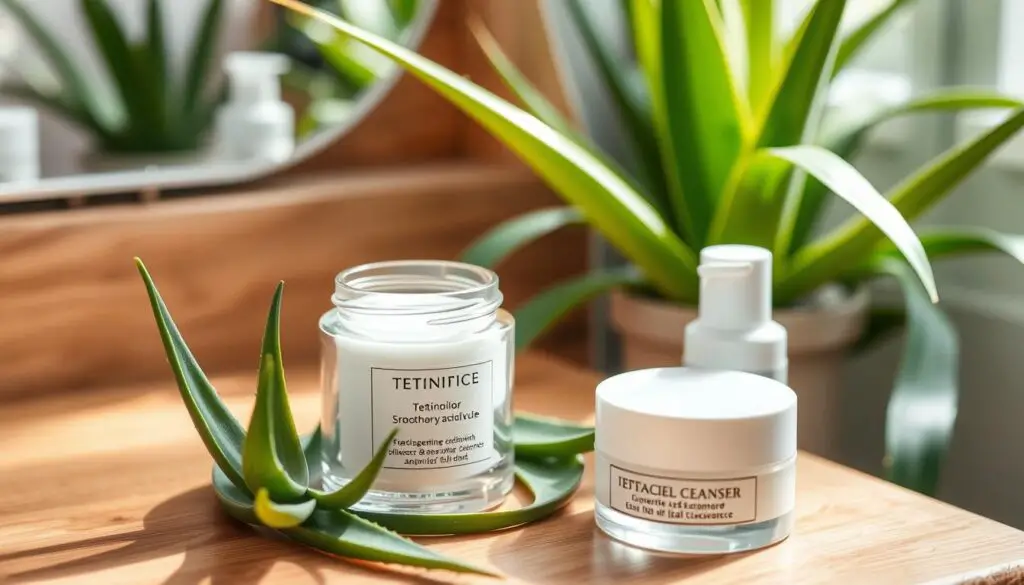
Professional Guidance is Key
Seeing a dermatologist is the first and most important step. They offer advice tailored to your skin. A professional skincare consultation helps decide if tretinoin is right for you.
Understanding Your Skin Type
Knowing your skin type is key before starting tretinoin. Different skin types react differently to this strong retinoid. Think about these important factors:
- Sensitivity levels
- Existing skin conditions
- Potential reaction tendencies
- Hydration requirements
Safety First: Patch Testing
Patch testing is crucial to avoid bad reactions. Follow these important steps:
- Select a small, discrete area of skin
- Apply a minimal amount of tretinoin
- Monitor the area for 24-48 hours
- Watch for signs of irritation or allergic response
“Prevention is always better than cure, especially when it comes to skincare.”
Using tretinoin in your skincare routine needs patience and careful watching. Your skin’s response is the most important thing. So, be cautious and follow professional advice.
Building Your Skincare Routine
Creating a skincare routine with tretinoin needs careful planning. It’s different from regular skincare because it focuses on how you apply products and protect your skin.
Morning vs. Evening Routine
Tretinoin is best used at night because it’s sensitive to sunlight. In the morning, focus on hydrating and protecting your skin from the sun. At night, apply tretinoin.
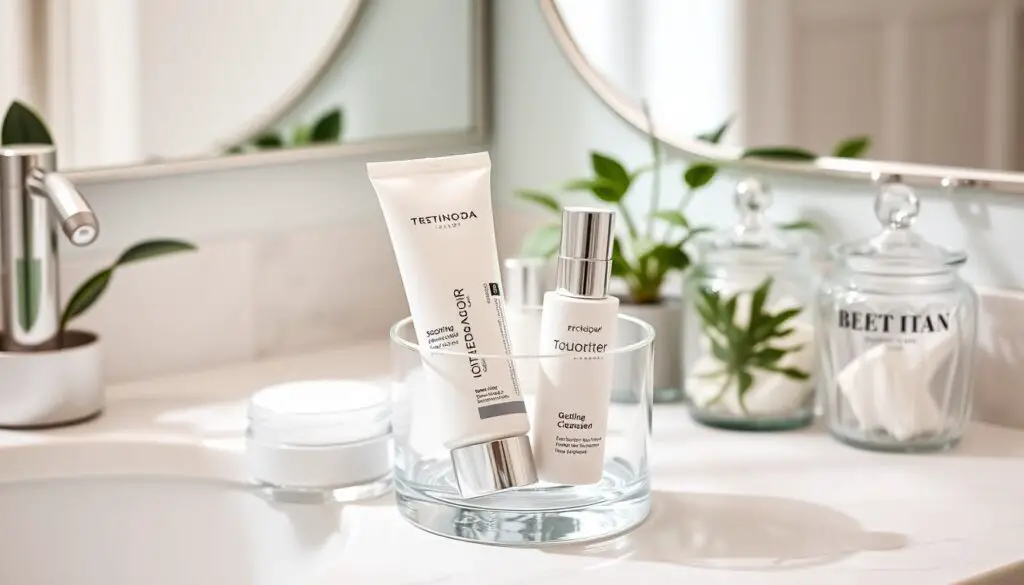
Essential Products to Use
When making your skincare routine with tretinoin, remember these key products:
- Gentle, fragrance-free cleanser
- Hydrating moisturizer with hyaluronic acid
- Broad-spectrum SPF 30+ sunscreen
- Mild, non-irritating serum
Steps to Incorporate Tretinoin
Start using tretinoin slowly. Begin with a low dose and use it less often. This lets your skin get used to it.
- Cleanse face with gentle cleanser
- Apply thin layer of moisturizer
- Use pea-sized amount of tretinoin
- Wait 20-30 minutes before additional products
*”Patience is key when starting your tretinoin journey. Your skin needs time to adapt.”*
Studies show tretinoin can help with sun damage, acne, and fine lines. It boosts collagen production. With regular and careful use, you can see big improvements in your skin.
How to Introduce Tretinoin Gradually
Starting a tretinoin skincare routine needs patience and a careful plan. Dermatologists say it’s key to start slow to avoid skin irritation. Knowing the right amount and how often to use it is very important.
Starting Slow: Application Frequency
To add tretinoin to your routine, start with a small amount and use it a little. Studies show 70% of people get some irritation at first. Here’s a good way to start:
- Start with a low concentration (0.025%)
- Apply twice a week at first
- Use a pea-sized amount for your whole face
- Slowly increase how often you use it over 4-6 weeks
Observing Your Skin’s Response
It’s important to watch how your skin reacts to tretinoin. Studies show starting slow can cut irritation by 40% compared to using it every day.
| Week | Frequency | Expected Response |
|---|---|---|
| 1-2 | Twice per week | Initial adaptation |
| 3-4 | Three times per week | Increased tolerance |
| 5-6 | Every other night | Improved skin adjustment |
“Patience is the secret to successful tretinoin integration into your skincare routine.” – Dermatology Experts
Look out for signs of too much irritation like constant redness, burning, or peeling. If you see these, use it less or talk to your dermatologist. Remember, 80% of users say their skin feels better after regular use.
Reducing Irritation When Using Tretinoin
Using tretinoin for anti-aging skincare needs a careful plan to avoid skin sensitivity. It’s important to watch how your skin reacts and take steps to protect it.
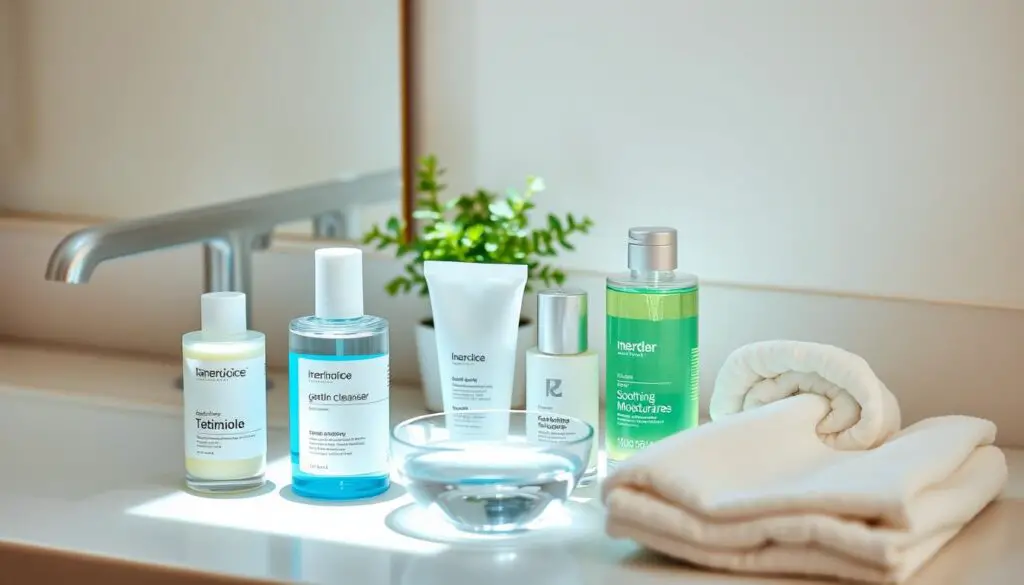
Importance of Moisturizing
Moisturizing is key when using tretinoin. This strong retinoid can dry out and irritate your skin. Studies show 10-30% of people get some skin sensitivity from retinoids.
- Choose moisturizers with hyaluronic acid
- Look for products containing ceramides
- Select non-comedogenic formulations
- Apply moisturizer immediately after tretinoin
Choosing Gentle Cleansers
Your cleanser is crucial in avoiding tretinoin irritation. Go for mild, fragrance-free cleansers that don’t harm your skin’s natural barrier.
| Cleanser Characteristics | Recommended Features |
|---|---|
| pH Level | Balanced (5.5-6.5) |
| Ingredients | Ceramides, Glycerin |
| Texture | Creamy, Hydrating |
The Role of Hydrating Serums
Hydrating serums help protect your skin from tretinoin’s drying effects. Ingredients like niacinamide can reduce inflammation and keep your skin hydrated.
*”Proper hydration is key to minimizing tretinoin-related irritation and maintaining healthy skin.”*
By following these tretinoin skincare tips, you’ll help your skin transform smoothly and comfortably. This ensures a better anti-aging experience.
Identifying Common Side Effects
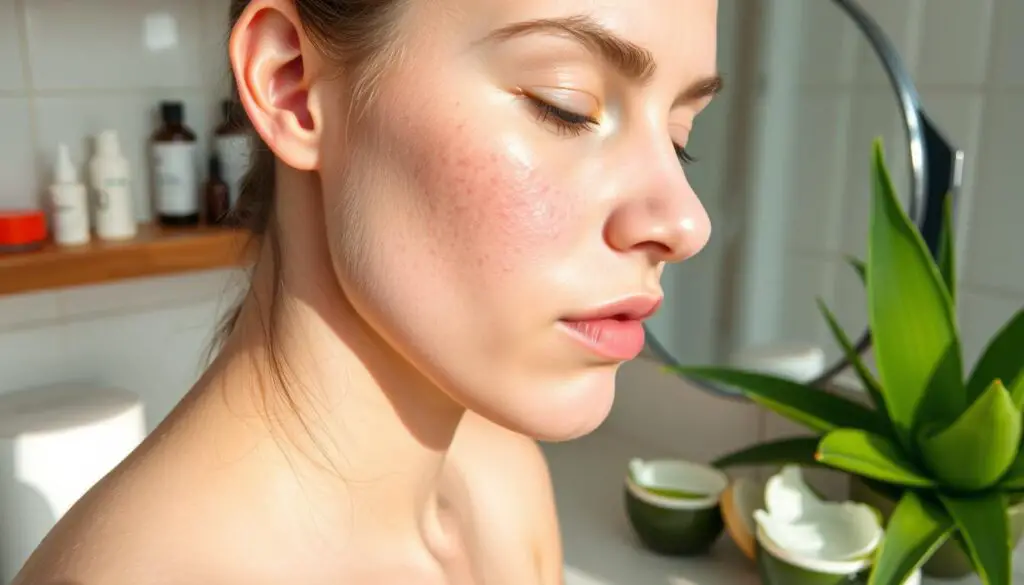
Starting a tretinoin skincare routine can change your skin for the better. But, it’s important to know about possible side effects. Your skin will go through big changes as it gets used to this strong cream.
Expected Reactions After Use
When you first start using tretinoin, you might notice a few things:
- Mild redness and skin irritation
- Dry, flaky skin patches
- Increased sensitivity to sunlight
- Temporary increased acne breakouts (purging phase)
“Skin adjustment is normal and typically resolves within 4-6 weeks of consistent use.” – Dermatology Experts
When to Seek Professional Help
Most side effects are mild, but some need quick medical help:
- Severe burning or stinging sensations
- Extensive rashes or widespread skin inflammation
- Persistent swelling or extreme discomfort
- Signs of allergic reaction
About 75% of users try to figure out their skin issues on their own. But, talking to a dermatologist is a good idea. They can help you use tretinoin safely and right.
Dermatologists say to watch your skin closely. If side effects last more than 8 weeks or get worse, see a doctor. This way, you can keep your skin healthy and get the most out of your treatment.
Tips for Using Tretinoin Effectively
Mastering your tretinoin skincare routine is key. It involves understanding strategies that boost results and avoid irritation. Tretinoin is a strong ingredient that needs careful use and consistent application.
Timing Your Application Matters
Timing is everything when using tretinoin. Apply it at night, after you’ve cleaned your face. Wait 20-30 minutes for your skin to dry. This helps prevent irritation.
- Apply on clean, dry skin
- Use a pea-sized amount for entire face
- Avoid immediate application after showering
Smart Product Layering Techniques
Layering products wisely is important. Start with thin products and move to thicker ones. So, apply tretinoin first, then moisturizers.
| Product Type | Recommended Action |
|---|---|
| Serums | Apply before tretinoin |
| Moisturizers | Apply after tretinoin |
| Sunscreen | Morning application only |
Consistency is Key
Using tretinoin regularly is crucial for best results. It may take weeks to see improvements, but sticking with it can change your skin. Dermatologists suggest starting with 2-3 times a week and increasing as your skin gets used to it.
“Patience and persistence are your greatest allies in a successful tretinoin skincare journey.” – Dermatology Experts
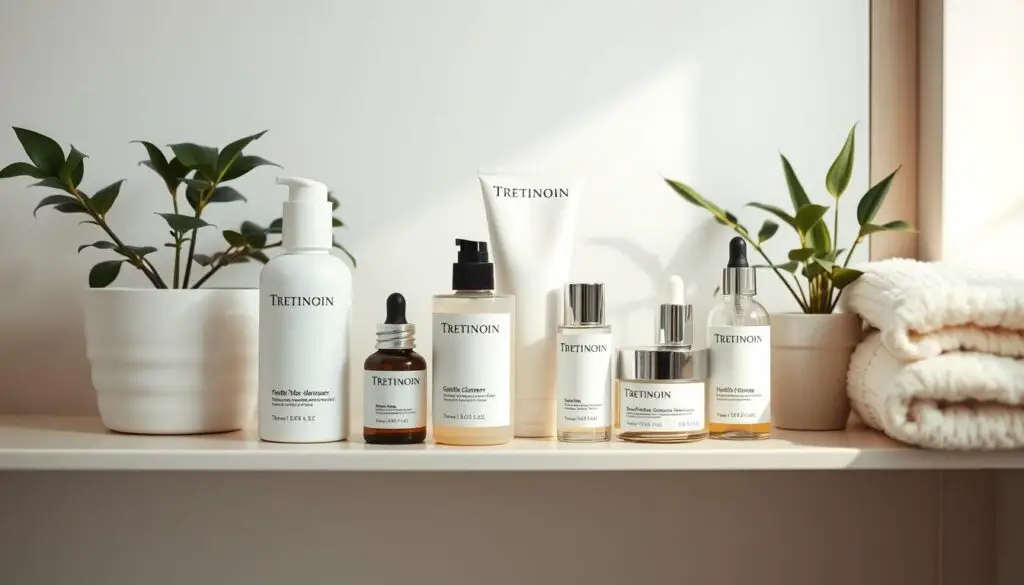
Adjusting Your Routine Based on Season
Your skincare routine with tretinoin needs to change with the seasons. Knowing how the weather affects your skin is key to keeping it looking young all year.

When using tretinoin for anti-aging, you must be ready to adjust. The weather changes mean your skin needs different care to stay healthy and strong.
Summer Skincare Tips
Summer brings special challenges for tretinoin users. Your skin is more sensitive to the sun, so you need to take extra steps:
- Use a broad-spectrum SPF 50+ sunscreen daily
- Reduce tretinoin application frequency if experiencing increased sensitivity
- Wear protective clothing and seek shade during peak sun hours
- Consider using a lower concentration of tretinoin during summer months
Winter Care for Sensitive Skin
Winter can make your skin dry and irritated, especially with tretinoin. Here’s how to protect it:
- Switch to a richer, more hydrating moisturizer
- Apply tretinoin less frequently to prevent excessive dryness
- Use gentle, fragrance-free skincare products
- Add a hyaluronic acid serum for extra hydration
*”Listen to your skin and be willing to adjust your tretinoin routine as needed.”*
Having a flexible skincare routine with tretinoin lets you enjoy its benefits all year. Your skin’s needs will shift, so be ready to adapt your care.
Additional Ingredients to Combine with Tretinoin
Creating a tretinoin skincare regimen means knowing which ingredients go well with it. How you mix tretinoin into your skincare can greatly affect your skin’s health and look.
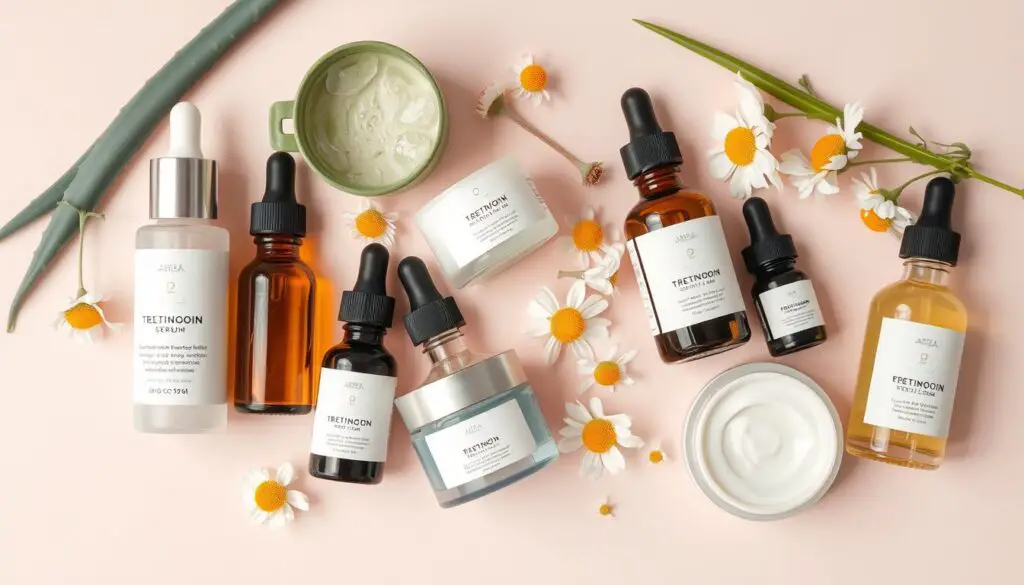
Powerful Serums to Enhance Tretinoin
Choose serums that are gentle and hydrating to go with tretinoin. These should help your skin heal. Some good choices are:
- Niacinamide: It helps reduce inflammation and even out your skin tone.
- Hyaluronic acid: It gives your skin deep hydration without blocking pores.
- Vitamin C: It boosts collagen and makes your skin brighter.
Sunscreen: Your Essential Tretinoin Companion
Using sunscreen is key when you’re on tretinoin, as it makes your skin more sensitive. Look for a broad-spectrum SPF 30+ that is:
- Light and not greasy
- Based on minerals
- Water-resistant
*”Protecting your skin is just as important as treating it.”*
Your tretinoin skincare plan should focus on gentle, hydrating items. These should help your skin renew itself while keeping irritation low. Always add new products slowly and watch how your skin reacts.
Lifestyle Factors to Consider
Your tretinoin skincare journey is more than just applying products. Lifestyle choices are key to getting the most out of tretinoin. Knowing how diet, hydration, and stress affect your skin can boost your skincare routine.
Nutrition and Skin Health
Your diet affects your skin’s look and how it reacts to tretinoin. Add these foods to your diet:
- Antioxidant-rich fruits and vegetables
- Omega-3 fatty acids from fish and nuts
- Lean proteins for collagen support
- Hydrating foods like watermelon and cucumber
Hydration’s Critical Role
Drinking enough water is vital for skin health and tretinoin’s effectiveness. Drink at least 8 glasses a day to keep your skin moist and reduce irritation.
| Hydration Level | Skin Impact |
|---|---|
| Low Water Intake | Increased dryness, potential tretinoin sensitivity |
| Adequate Hydration | Improved skin resilience, better tretinoin absorption |
Managing Stress for Skin Health
Stress can harm your skin, making it worse with tretinoin. Try these stress-reducing methods:
- Meditation
- Regular exercise
- Adequate sleep
- Mindfulness practices
“Your skin reflects your overall health and well-being.” – Dermatology Insight
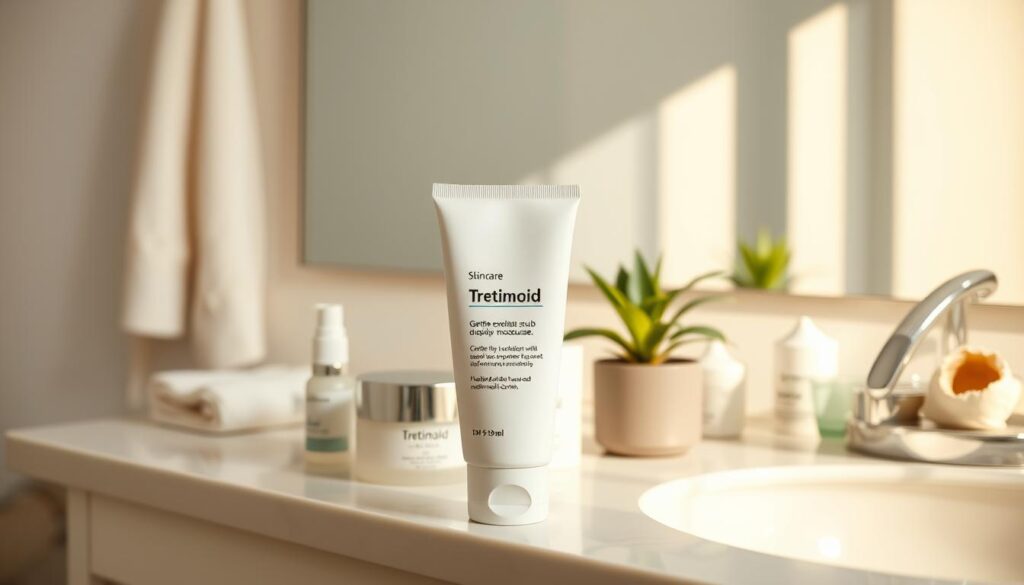
By focusing on these lifestyle aspects, you’ll improve your skincare routine. This approach will help tretinoin work better and keep your skin healthy for longer.
Understanding the Long-Term Effects of Tretinoin
Tretinoin is a strong treatment for anti-aging skincare. It offers long-term benefits for your skin. Knowing how your skin will change is key to keeping it healthy.
People using tretinoin see big changes in their skin. Studies show it works well. Most people notice big changes in a few months.
Visible Improvements Over Time
- First 4-6 weeks: Initial skin texture refinement
- 3-6 months: Significant reduction in fine lines
- 6-12 months: Enhanced collagen production
- 1-2 years: Sustained skin rejuvenation
In the first five years, you could see up to a 30% better skin quality. A study showed a 65-year-old patient got better skin tone and less damage from the sun.
Maintenance After Achieving Goals
Getting the results you want takes planning. Here are some tips for keeping your skin looking good:
- Gradually reduce tretinoin frequency
- Maintain consistent sun protection
- Use complementary hydrating products
- Regular dermatologist consultations
“Consistency is key in tretinoin treatment. Your skin’s transformation is a journey, not a destination.”
Tretinoin comes in different strengths, from 0.01% to 0.1%. Start with a lower strength and adjust as needed. Getting the best results takes time, sun protection, and a complete skincare routine.
Frequently Asked Questions About Tretinoin
Exploring tretinoin can be tricky. Many people wonder about this strong retinoid and how to use it right. Let’s tackle some common questions to make tretinoin clearer.
Combining Tretinoin with Other Treatments
Knowing which products go together with tretinoin is key. Not all treatments mix well. Here’s what you can and can’t mix with tretinoin:
- Avoid using benzoyl peroxide at the same time as tretinoin
- Vitamin C serums can be used, but best applied at different times of day
- Niacinamide is generally safe to use with tretinoin
- Hyaluronic acid can help reduce potential irritation
Timeline for Seeing Results
Being patient is important when using tretinoin. Results can vary based on your skin:
| Skin Concern | Typical Improvement Timeline |
|---|---|
| Acne | 8-12 weeks |
| Fine Lines | 3-6 months |
| Skin Texture | 4-6 months |
“Tretinoin is a marathon, not a sprint. Consistency is your greatest ally in achieving remarkable skin transformation.” – Dermatology Experts
For the best results, stick to a routine and always use sunscreen with tretinoin. Your skin will appreciate your dedication!
Common Misconceptions About Tretinoin
Tretinoin is a strong skincare treatment with many myths. Knowing the truth about this skincare solution helps you use it wisely in your skincare routine.
Many believe wrong things about tretinoin, missing out on its benefits. Let’s clear up some common myths and facts.
Debunking Popular Tretinoin Myths
- Myth: Tretinoin thins your skin
Reality: It actually boosts collagen, making your skin thicker and stronger. Studies show it can increase collagen by over 80%, making your skin more resilient.
- Myth: Tretinoin works overnight
Studies show it takes 3-6 months to see results. Being patient is important when using tretinoin.
- Myth: Tretinoin is only for acne treatment
While it’s great for acne, it also reduces fine lines, evens skin tone, and improves texture.
Understanding Usage Concerns
About 60-70% of new users face skin reactions like redness and irritation. This is normal as your skin adjusts. Starting with lower doses (0.01%-0.05%) can reduce these issues.
“Knowledge is the first step in effective skincare. Understanding tretinoin helps you use it correctly and maximize its potential.” – Dermatology Expert
Used right, tretinoin can change your skincare game. Always talk to a healthcare pro to find the best way to use it for your skin.
Staying Motivated on Your Skincare Journey
Starting a skincare routine with tretinoin can be tough. But, staying motivated is crucial for your skin goals. Your tretinoin skincare plan needs patience, consistency, and a positive attitude.
Tracking Your Progress
Keeping track of your skincare journey keeps you motivated and shows real results. Here are some ways to track:
- Take weekly progress photos in consistent lighting
- Maintain a digital skin journal
- Record product usage and skin reactions
- Use smartphone apps for skin tracking
Celebrating Small Wins
Your tretinoin skincare routine is a long-term effort. Acknowledge and celebrate small victories:
- Reduced acne breakouts
- Smoother skin texture
- Decreased hyperpigmentation
- Improved overall skin tone
“Progress is not always linear, but it is always meaningful.” – Skincare Expert
Remember, everyone’s skin reacts differently to tretinoin. Be patient, consistent, and kind to yourself on this skincare journey.
Final Thoughts on Your Tretinoin Routine
Starting a tretinoin skincare journey takes dedication and patience. Using tretinoin can greatly improve your skin’s health and look. It might seem tough, but learning how to use it well will lead to great results.
Improving your skin takes time. Dermatologists say to use it every day and watch how your skin reacts. With tretinoin, you’ll see your skin get smoother, lines will lessen, and collagen will grow. Keep in mind, your skin’s needs will change, so stay alert and adjust your routine.
Embracing Change for Better Skin
Always protect and hydrate your skin with tretinoin. Wearing sunscreen with SPF 30+ daily is key to avoiding more damage. Adding ingredients like hyaluronic acid can help keep your skin moist and strong.
Recommendations for Ongoing Care
Seeing a dermatologist regularly is important for your skin’s health. As you get older, your skin’s needs will change, especially after menopause. Stay ahead, listen to your skin, and tweak your routine as needed to keep your skin healthy and glowing.
